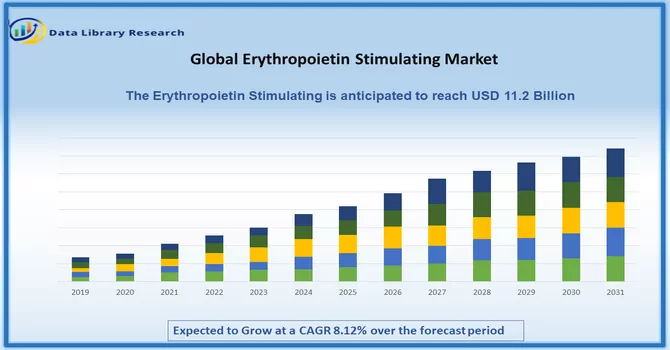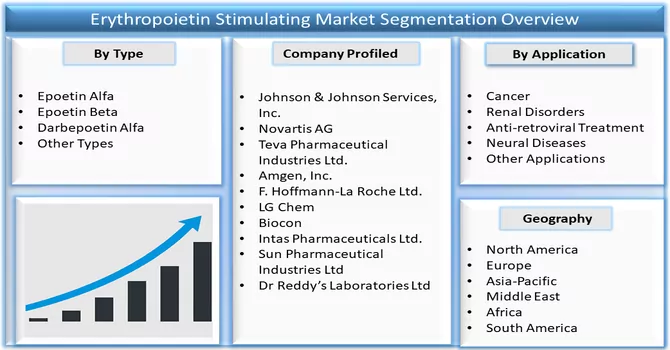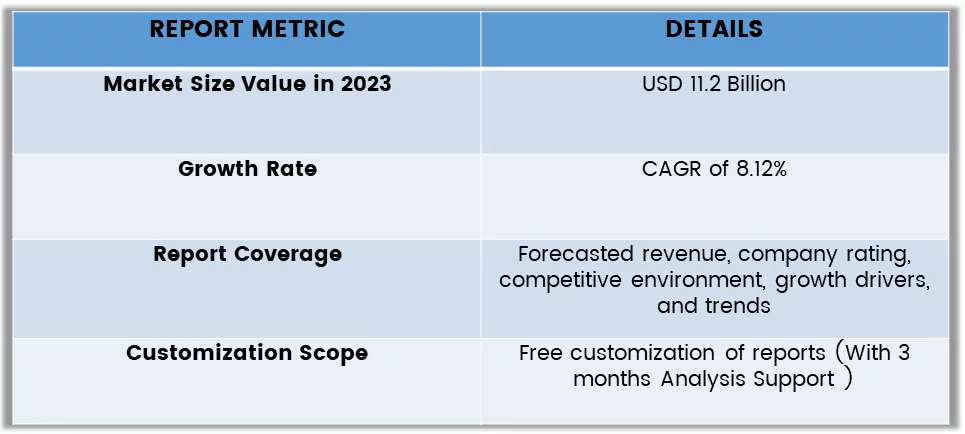Erythropoietin Stimulating Market Overview and Analysis:
The global erythropoietin market size was valued at USD 11.2 billion in 2023 and is expected to expand at a CAGR of 8.12% during the forecast period 2024-2031.

Get Complete Analysis Of The Report - Download Free Sample PDF
The market overview of Erythropoietin Stimulating Agents (ESAs) reveals a significant and evolving landscape within the pharmaceutical and healthcare sectors. ESAs, primarily known for their role in stimulating red blood cell production, find extensive application in the management of anemia, particularly in patients with chronic kidney disease and cancer undergoing certain treatments. The market has witnessed a notable increase in research and development activities aimed at expanding the clinical indications and improving the safety and efficacy profiles of ESAs. Despite their established therapeutic benefits, concerns regarding potential adverse effects, including cardiovascular risks, have influenced regulatory scrutiny and prescribing practices.
The evolving market dynamics are also shaped by biosimilar competition, prompting healthcare providers and stakeholders to navigate a balance between cost-effectiveness and ensuring optimal patient outcomes. As advancements in understanding erythropoiesis continue, the Erythropoietin Stimulating Agents market remains dynamic, responding to the complex interplay of scientific progress, regulatory considerations, and healthcare economics. A key growth-driving factor for the Erythropoietin Stimulating Agents (ESAs) market lies in the expanding prevalence of conditions associated with anemia, such as chronic kidney disease and cancer. As the global population ages and the incidence of chronic diseases rises, there is a heightened demand for therapeutic interventions to manage anemia effectively. ESAs, known for their role in stimulating red blood cell production, play a crucial part in addressing anemia-related complications and improving the quality of life for affected individuals. Furthermore, ongoing research and development efforts focused on enhancing the safety and efficacy of ESAs contribute to the market's growth by introducing innovative formulations and expanding the range of clinical applications. The evolving landscape of healthcare, with a growing emphasis on personalized medicine and improved patient outcomes, positions ESAs as essential components in the treatment paradigm, thereby driving the market forward.
Market Segmentation: The Erythropoietin Stimulating Agents Market is segmented by Type (Epoetin Alfa, Epoetin Beta, Darbepoetin Alfa, And Other Types), Application (Cancer, Renal Disorders, Anti-retroviral Treatment, Neural Diseases, and Other Applications), and Geography (North America, Europe, Asia-Pacific, Middle East and Africa, and South America). The report offers the value (in USD million) for the above segments.

For Detailed Market Segmentation - Download Free Sample PDF
Erythropoietin Stimulating Market Trends:
The market trends in the Erythropoietin Stimulating Agents (ESAs) market reflect a dynamic landscape influenced by evolving healthcare paradigms. There is a discernible shift towards biosimilars, driven by the need for cost-effective alternatives without compromising therapeutic efficacy. The market is witnessing increased diversification of ESAs applications, with ongoing research exploring their potential benefits in conditions beyond traditional indications, such as neuroprotection and tissue repair. Moreover, advancements in drug delivery systems are enhancing patient convenience and compliance, contributing to the overall market expansion. Regulatory scrutiny and safety considerations are shaping prescribing practices, emphasizing the importance of individualized treatment approaches. As the healthcare industry continues to prioritize value-based care and personalized medicine, the Erythropoietin Stimulating Agents market is characterized by a trend towards innovation, adaptability, and a holistic approach to addressing anemia and related conditions. Market Drivers: The increasing prevalence of chronic kidney disease The escalating prevalence of chronic kidney disease (CKD) stands as a pivotal driver for the Erythropoietin Stimulating Agents (ESAs) market. CKD often leads to anemia due to impaired erythropoietin production by the kidneys, necessitating therapeutic interventions like ESAs to stimulate red blood cell formation. As the global burden of CKD rises, driven by factors such as aging populations and the growing incidence of diabetes and hypertension, the demand for ESAs as a crucial component in managing anemia associated with CKD continues to surge. This prevailing health challenge not only underscores the significance of ESAs in improving the quality of life for CKD patients but also propels ongoing research and development efforts to optimize treatment strategies and address the evolving needs of this expanding patient population within the market. Cancer-related anemia Cancer-related anemia emerges as a compelling driver for the Erythropoietin Stimulating Agents (ESAs) market, reflecting the crucial role of these agents in addressing anemia associated with malignancies and cancer treatments. Chemotherapy and radiation therapy often contribute to decreased red blood cell production, leading to anemia and associated fatigue in cancer patients. ESAs play a pivotal role in managing cancer-related anemia by stimulating the production of red blood cells, thereby alleviating symptoms and improving the overall quality of life for individuals undergoing cancer treatment. The increasing incidence of cancer globally, coupled with a growing focus on optimizing supportive care, propels the demand for ESAs in oncology settings. This scenario underscores the significance of ESAs in the comprehensive care of cancer patients, driving ongoing research and development endeavors to enhance the safety and efficacy profiles of these agents within the dynamic landscape of cancer-related anemia.
Market Restraints:
Several market restraints challenge the Erythropoietin Stimulating Agents (ESAs) market, with one major factor being heightened scrutiny and regulatory constraints on the use of these agents. Concerns about potential cardiovascular risks associated with ESAs have led to more stringent regulatory measures and prescribing guidelines, impacting their widespread adoption. Additionally, the advent of biosimilars introduces pricing pressures, challenging the market's profitability and potentially hindering the growth of originator ESAs. The saturation of mature markets and the slow adoption of novel ESAs in emerging economies present market entry barriers, limiting the global reach of these agents. Furthermore, the increasing preference for alternative treatments, such as blood transfusions and iron supplementation, in certain clinical scenarios poses a restraint on the market's expansion. As a result, the Erythropoietin Stimulating Agents market grapples with a complex interplay of regulatory challenges, pricing dynamics, and evolving treatment paradigms, shaping the landscape of constraints within the industry.
COVID-19 Impact on Erythropoietin Stimulating Market:
The Erythropoietin Stimulating Agents (ESAs) market has encountered a multifaceted impact due to the COVID-19 pandemic. The disruptions in healthcare systems, diversion of resources towards managing the pandemic, and heightened focus on infection control have influenced the administration and management of ESAs, particularly in non-emergency settings. The pandemic-induced economic strain has prompted cost considerations, impacting the adoption of ESAs, with healthcare facilities and providers navigating budget constraints. Furthermore, the pandemic has brought attention to the vulnerability of certain patient populations, such as those with chronic kidney disease or cancer, for whom ESAs are vital. The ongoing global health crisis has emphasized the need for resilient and adaptable healthcare strategies, which may, in turn, shape the future landscape of the Erythropoietin Stimulating Agents market as it continues to navigate the complexities arising from the COVID-19 pandemic.
Segmental Analysis:
Epoetin Beta Segment is Expected to Witness Significant Growth Over the Forecast Period
Epoetin beta, a synthetic form of erythropoietin, offers several advantages in the treatment of anemia. It stimulates the production of red blood cells in the bone marrow, helping to alleviate the symptoms of anemia, such as fatigue and weakness, and improve quality of life. Epoetin beta is particularly beneficial for patients with chronic kidney disease or cancer undergoing chemotherapy, as it can reduce the need for blood transfusions and improve hemoglobin levels. Its ability to increase red blood cell production also makes it valuable in reducing the risk of complications associated with anemia, such as cardiovascular events and the need for hospitalization. Additionally, the long-acting nature of epoetin beta allows for less frequent dosing, improving patient convenience and adherence to treatment regimens.
Renal Disorder Segment is Expected to Witness Significant Growth Over the Forecast Period
Erythropoietin (EPO) is commonly used in the treatment of renal disorders, particularly in patients with chronic kidney disease (CKD) who develop anemia. CKD often leads to a decrease in the production of erythropoietin by the kidneys, resulting in reduced red blood cell production and anemia. EPO therapy helps stimulate the bone marrow to produce more red blood cells, improving hemoglobin levels and reducing the need for blood transfusions in these patients. By managing anemia, EPO therapy can improve quality of life, reduce fatigue, and lower the risk of complications associated with CKD, such as cardiovascular events. EPO therapy is typically administered as an injection and is an important part of the overall management of anemia in patients with renal disorders. Thus, the segment is expected to witness significant growth over the forecast period.
North America Region is Expected to Witness Significant Growth Over the Forecast Period
The North American market for erythropoietin stimulating agents (ESAs) is projected to dominate due to the region's high prevalence of disorders leading to anemia. However, the treatment landscape for anemia, particularly in patients with aplastic anemia, has been significantly impacted by the COVID-19 pandemic. Patients receiving active treatment for aplastic anemia face challenges such as immunosuppression and limited hospital resources for necessary treatments like anti-thymocyte globulin administration, increasing the risk of COVID-19 exposure and complicating anemia management. ESAs are crucial in treating various chronic diseases prevalent in North America, including chronic kidney disease (CKD), cancer, neural, and HIV infections. The region, particularly the United States, has a high incidence of cancer, with breast cancer being the most prevalent. This high cancer incidence drives the demand for ESAs to manage anemia in cancer patients, contributing to the market's growth. Additionally, the rising number of people at high risk for CKD, such as those with diabetes or hypertension, further propels the demand for ESAs in North America. Thus, the segment is expected to witness significant growth over the forecast period.

Get Complete Analysis Of The Report - Download Free Sample PDF
Erythropoietin Stimulating Market Competitive Landscape:
The analyzed market exhibits a high degree of fragmentation, primarily attributable to the presence of numerous players operating on both a global and regional scale. The competitive landscape is characterized by a diverse array of companies, each contributing to the overall market dynamics. This fragmentation arises from the existence of specialized solution providers, established industry players, and emerging entrants, all vying for market share. The diversity in market participants is underscored by the adoption of various strategies aimed at expanding the company presence. On a global scale, companies within the studied market are strategically positioning themselves through aggressive expansion initiatives. This often involves entering new geographical regions, targeting untapped markets, and establishing a robust global footprint. The pursuit of global expansion is driven by the recognition of diverse market opportunities and the desire to capitalize on emerging trends and demands across different regions. Simultaneously, at the regional level, companies are tailoring their approaches to align with local market dynamics. Regional players are leveraging their understanding of specific market nuances, regulatory environments, and consumer preferences to gain a competitive edge. This regional focus allows companies to cater to the unique needs of local clientele, fostering stronger market penetration. To navigate the complexities of the fragmented market, companies are implementing a range of strategies. These strategies include investments in research and development to stay at the forefront of technological advancements, mergers and acquisitions to consolidate market share, strategic partnerships for synergies, and innovation to differentiate products and services. The adoption of such multifaceted strategies reflects the competitive nature of the market, with participants continually seeking avenues for growth and sustainability. In essence, the high fragmentation in the studied market not only signifies the diversity of players but also underscores the dynamism and competitiveness that drive ongoing strategic maneuvers. As companies explore various avenues for expansion, the market continues to evolve, presenting both challenges and opportunities for industry stakeholders.
Some of the key players in the global erythropoietin drugs market include:
- Johnson & Johnson Services, Inc.
- Novartis AG
- Teva Pharmaceutical Industries Ltd.
- Amgen, Inc.
- F. Hoffmann-La Roche Ltd.
- LG Chem
- Biocon
- Intas Pharmaceuticals Ltd.
- Sun Pharmaceutical Industries Ltd
- Dr Reddy’s Laboratories Ltd
Recent Development:
1) In July 2020, PT Kalbe Genexine Biologics commenced a Phase III clinical trial investigating the efficacy of Efepoetin Alfa for treating anemia in chronic kidney disease patients not undergoing dialysis. This pivotal study aims to assess the therapeutic potential of Efepoetin Alfa in addressing anemia associated with chronic kidney disease, expanding the understanding of its clinical benefits beyond the dialysis patient population. Concurrently,
2) In February 2020, Samsung Medical Center initiated a Phase III clinical trial, employing a multicenter randomized approach, to evaluate the effectiveness of intravenous iron injection, specifically Ferinject in managing anemia among cancer patients. This study underscores the ongoing commitment to advancing treatment options for anemia in cancer care, emphasizing the exploration of alternative therapeutic interventions like intravenous iron to enhance the quality of life for individuals undergoing cancer treatment. Both trials signify significant strides in research, contributing valuable insights to the evolving landscape of anemia management in diverse patient populations.
Frequently Asked Questions (FAQ) :
Q1. What was the Erythropoietin Stimulating Market size in 2023?
As per Data Library Research the global erythropoietin market size was valued at USD 11.2 billion in 2023.
Q2. What is the Growth Rate of the Erythropoietin Stimulating Market ?
Erythropoietin Stimulating Market is expected to expand at a CAGR of 8.12% during the forecast period.
Q3. What are the factors on which the Erythropoietin Stimulating Market research is based on?
By Type, By Application and Geography are the factors on which the Erythropoietin Stimulating Market research is based.
Q4. Which region has the largest share of the Erythropoietin Stimulating market? What are the largest region's market size and growth rate?
North America has the largest share of the market. For detailed insights on the largest region's market size and growth rate request a sample here.
Request for TOC
Data Library Research are conducted by industry experts who offer insight on industry structure, market segmentations technology assessment and competitive landscape (CL), and penetration, as well as on emerging trends. Their analysis is based on primary interviews (~ 80%) and secondary research (~ 20%) as well as years of professional expertise in their respective industries. Adding to this, by analysing historical trends and current market positions, our analysts predict where the market will be headed for the next five years. Furthermore, the varying trends of segment & categories geographically presented are also studied and the estimated based on the primary & secondary research.
In this particular report from the supply side Data Library Research has conducted primary surveys (interviews) with the key level executives (VP, CEO’s, Marketing Director, Business Development Manager and SOFT) of the companies that active & prominent as well as the midsized organization
FIGURE 1: DLR RESEARH PROCESS

Extensive primary research was conducted to gain a deeper insight of the market and industry performance. The analysis is based on both primary and secondary research as well as years of professional expertise in the respective industries.
In addition to analysing current and historical trends, our analysts predict where the market is headed over the next five years.
It varies by segment for these categories geographically presented in the list of market tables. Speaking about this particular report we have conducted primary surveys (interviews) with the key level executives (VP, CEO’s, Marketing Director, Business Development Manager and many more) of the major players active in the market.
Secondary ResearchSecondary research was mainly used to collect and identify information useful for the extensive, technical, market-oriented, and Friend’s study of the Global Extra Neutral Alcohol. It was also used to obtain key information about major players, market classification and segmentation according to the industry trends, geographical markets, and developments related to the market and technology perspectives. For this study, analysts have gathered information from various credible sources, such as annual reports, sec filings, journals, white papers, SOFT presentations, and company web sites.
Market Size EstimationBoth, top-down and bottom-up approaches were used to estimate and validate the size of the Global market and to estimate the size of various other dependent submarkets in the overall Extra Neutral Alcohol. The key players in the market were identified through secondary research and their market contributions in the respective geographies were determined through primary and secondary research.
Forecast Model




